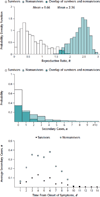Effect of Ebola progression on transmission and control in Liberia
- PMID: 25347321
- PMCID: PMC4402942
- DOI: 10.7326/M14-2255
Effect of Ebola progression on transmission and control in Liberia
Abstract
Background: The Ebola outbreak that is sweeping across West Africa is the largest, most volatile, and deadliest Ebola epidemic ever recorded. Liberia is the most profoundly affected country, with more than 3500 infections and 2000 deaths recorded in the past 3 months.
Objective: To evaluate the contribution of disease progression and case fatality on transmission and to examine the potential for targeted interventions to eliminate the disease.
Design: Stochastic transmission model that integrates epidemiologic and clinical data on incidence and case fatality, daily viral load among survivors and nonsurvivors evaluated on the basis of the 2000-2001 outbreak in Uganda, and primary data on contacts of patients with Ebola in Liberia.
Setting: Montserrado County, Liberia, July to September 2014.
Measurements: Ebola incidence and case-fatality records from 2014 Liberian Ministry of Health and Social Welfare.
Results: The average number of secondary infections generated throughout the entire infectious period of a single infected case, R, was estimated as 1.73 (95% CI, 1.66 to 1.83). There was substantial stratification between survivors (RSurvivors), for whom the estimate was 0.66 (CI, 0.10 to 1.69), and nonsurvivors (RNonsurvivors), for whom the estimate was 2.36 (CI, 1.72 to 2.80). The nonsurvivors had the highest risk for transmitting the virus later in the course of disease progression. Consequently, the isolation of 75% of infected individuals in critical condition within 4 days from symptom onset has a high chance of eliminating the disease.
Limitation: Projections are based on the initial dynamics of the epidemic, which may change as the outbreak and interventions evolve.
Conclusion: These results underscore the importance of isolating the most severely ill patients with Ebola within the first few days of their symptomatic phase.
Primary funding source: National Institutes of Health.
Conflict of interest statement
Figures


Comment in
-
Effect of Ebola progression in Liberia.Ann Intern Med. 2015 May 19;162(10):734. doi: 10.7326/L15-5092. Ann Intern Med. 2015. PMID: 25984853 No abstract available.
-
Effect of Ebola progression in Liberia.Ann Intern Med. 2015 May 19;162(10):734. doi: 10.7326/L15-5092-2. Ann Intern Med. 2015. PMID: 25984854 No abstract available.
-
Effect of Ebola progression in Liberia.Ann Intern Med. 2015 May 19;162(10):734-5. doi: 10.7326/L15-5092-3. Ann Intern Med. 2015. PMID: 25984855 No abstract available.
References
-
- Ministry of Health and Social Welfare, Republic of Liberia. [on 30 September 2014];Liberia Ebola SitRep. 2014 123 Accessed at www.mohsw.gov.lr/documents/Liberia%20Ebola%20SitRep%20123Sept%2015,%2020....
-
- Althaus C. Estimating the reproduction number of Ebola virus (EBOV) during the 2014 outbreak in West Africa. [on 2 September 2014];PLOS Curr Outbreaks. 2014 Accessed at http://currents.plos.org/outbreaks/article/estimating-the-reproduction-n... - PMC - PubMed
-
- Nishiura H, Chowell G. Early transmission dynamics of Ebola virus disease (EVD), West Africa, March to August 2014. European Centre for Disease Prevention and Control (ECDC)–Health Comunication Unit. [on 30 September 2014];Eurosurveillance. 2014 19:20894. Accessed at www.eurosurveillance.org/ViewArticle.aspx?ArticleId=20894. - PubMed
-
- Formenty P. Ebola-Marburg viral diseases. In: Heymann DL, editor. Control of Communicable Diseases Manual. Washington, DC: American Public Health Assoc; 2008.
-
- Khan AS, Tshioko FK, Heymann DL, Le Guenno B, Nabeth P, Kerstiëns B, et al. The reemergence of Ebola hemorrhagic fever, Democratic Republic of the Congo, 1995. Commission de Lutte contre les Epidémies à Kikwit. J Infect Dis. 1999;179(Suppl 1):S76–S86. [PMID: 9988168] - PubMed
Publication types
MeSH terms
Grants and funding
LinkOut - more resources
Full Text Sources
Medical
Miscellaneous
